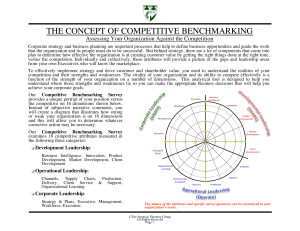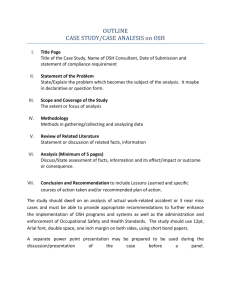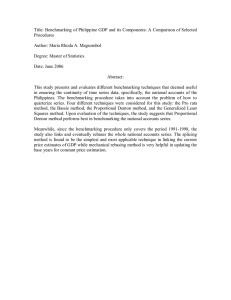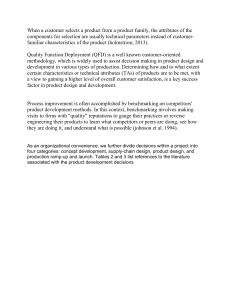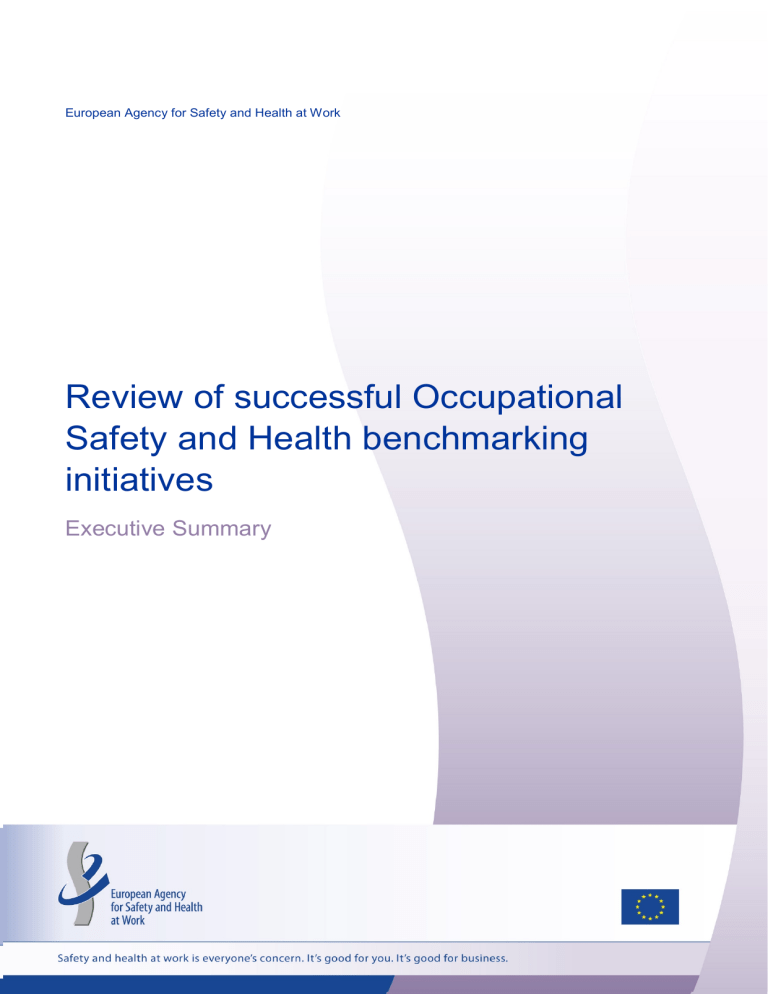
European Agency for Safety and Health at Work Review of successful Occupational Safety and Health benchmarking initiatives Executive Summary Review of successful OSH benchmarking initiatives – Executive summary Executive summary Within the European Agency for Safety and Health at Work (EU-OSHA) benchmarking has been defined as ‘a planned process by which an organisation compares its health and safety processes and performance with others to learn how to reduce accidents and ill health, improve compliance with health and safety law and/or cut compliance costs’. Using this definition, the overarching aim of this project was to review occupational safety and health (OSH) benchmarking schemes that have been set up at sector, Member State or European level. The research also set out to assess the benefits that such schemes can deliver, as well as their limitations, and to identify the key factors and main obstacles to their success. A number of methodologies — including a desk review, email questionnaire and an online survey — were used to identify OSH benchmarking schemes in Europe and capture details of their scope, activities and effectiveness. To supplement this information, a case-study approach was adopted to gain further understanding of selected schemes including their success factors and any barriers to progress. This involved in-depth interviews with scheme co-ordinators and participants in order to benefit from the knowledge and practical wisdom of those involved. In addition, a limited number of case studies of benchmarking schemes focusing on non-OSH topics were conducted to explore transferable insights. The review’s findings are illustrative of the diversity of available schemes and the range of sectors, topics and memberships covered. Across the 24 OSH schemes reviewed in depth, the nature of information-sharing requirements varies significantly, and includes both quantitative (i.e. OSH outcome) data and qualitative good practice (process) data. Many schemes contain elements of both. The benefits of benchmarking schemes for member organisations are plentiful. Calibration of their own performance against the market is a strong motivating factor for organisations to join a benchmarking scheme. Another strong driver is that of achieving improvements in accident and incident rates. For example, the Finnish Zero Accident Forum, a voluntary network of Finnish workplaces, found that members’ accident rates fell by 46 % between 2008 and 2012 while the national accident rate did not significantly alter over the period. The benchmarking activities of the United Kingdom’s Health and Safety Executive’s Paper and Board Industry Advisory Committee (PABIAC) coincided with a drop in accident rates in the paper-making industry: the rate has improved from an accident rate higher than construction in the 1990s to just above the all-industry average. A ‘vision of success’ is an attractive notion: many participants join with the wish of creating a zero-accident environment. Survey responses indicated that a wide variety of factors influence success, but that there is no one factor that all respondents agree on as critical to the success of their scheme. Data requirements emerged as a key factor, particularly with regard to participation and membership: benchmarking schemes with requirements to collect performance data are less attractive to members than those involving the sharing of good OSH practice. Focusing on features likely to be of most value to members is likely to lead to greater participation and success, although this should not preclude collection of data that scheme organisers believe will be of benefit, especially if it is key to tracking progress. Reporting accidents can be a sensitive issue and some members may be advised against sharing information about these: anonymous reporting could provide a means of addressing this. Virtual Risk Manager’s Fleet Safety Benchmarking scheme, for example, found that anonymity leads to more reliable data submissions and more productive discussions. The vast majority of schemes create opportunities for networking and discussion. For example, the Zero Accidents Network in the Netherlands found that face-to-face workgroups and forums were preferable to more passive panel discussions and lectures. These worked best in persuading attendees of the importance and applicability of other companies’ policies and processes to their own organisations. Several research interviewees discussed the importance of networking as instrumental in creating the relationships of trust and mutual collaboration that enable benchmarking schemes to be successful. The networking opportunities produced by the Universities Safety and Health Association, a forum for sharing best practice in the higher education sector, are among the most highly appreciated aspects of its activities. It found that most United Kingdom-based universities have good internal data-collection processes, so they consider the most important function of the quantitative data they produce is in comparing these data with those of other institutions. European Agency for Safety and Health at Work – EU-OSHA 1 Review of successful OSH benchmarking initiatives – Executive summary Schemes with ‘hands-on’ elements, such as on-site demonstration and those with opportunities for faceto-face discussion, are perceived as highly beneficial from the perspective of members. EU-OSHA’s Benchmarking Steering Group, found that hosting events in non-competitive ‘safe’ environments allows individuals to discuss contentious and sensitive issues and helps secure the collaborative mindset needed to promote benchmarking. Other considerations emerge as important, such as unit of membership (site rather than company membership, for example, can work better for some large firms) and criteria for membership. Schemes with broad (e.g. Finnish Zero Accident Forum) and narrow (e.g. HSE’s PABIAC scheme) sectoral bases can both work well. By opening membership to not only market leaders in OSH performance, but also aspirational underperformers, the Finnish Zero Accident Forum maximises opportunities for peer learning and support. The way goals are framed is also important; targets should be ambitious yet realistic. For Virtual Risk Manager’s Fleet Safety Benchmarking scheme it was considered counterproductive to have too fixed a strategy prior to development. Virtual Risk Manager believes that the discussions produced on and around the benchmarking forum are as important as the data themselves. Information gained from participation should be genuinely useful to the participants; if the scheme lacks perceived value, then participation is likely to decline owing to a lack of return on investment from the resources put in. On the whole, benchmarking participants prefer a focus on processes rather than outcomes, and practical examples of best practice are highly valued by members. The majority of respondents agreed that the ability to use information outputs to facilitate change was central to the success of a scheme. Schemes yielding documents containing OSH policies and processes are seen as useful, because this can save time developing documentation ‘from scratch’. Sharing electronic documentation is particularly useful. The use of multiple dissemination strategies, such as those used by BGM in Germany in its statutory accident insurance comprehensive incentive system, is also seen as an important success factor. Ease of participation is mentioned by many respondents. In the above-mentioned BGM scheme, questionnaires are as simple as possible to minimise bureaucratic barriers. A short, simple structure for the most recent survey in the United Kingdom HSE’s PABIAC scheme also resulted in a high response rate. Use of the phrases ‘good practice’ or ‘best practice’ should be considered carefully. Through its benchmarking activities, the ArcelorMittal Group, based in Luxembourg, found that a message of ‘good practice’ rather than ‘best practice’ was often more beneficial, as it was seen as offering guidance rather than imposing prescriptive procedures. Managers then feel they have greater ownership of the resultant OSH processes. There was less agreement between respondents on what characteristics of environments or schemes were disadvantageous. Those mentioned most often were onerous time or resource demands of membership and low levels of industry support. Where schemes involve collection of large amounts of empirical data they can come to resemble research projects and may be extremely resource intensive: methodologies such as face-to-face interviews or on-site audits of OSH processes should be approached with caution. The annex to the report is intended to serve as a practical guide for individuals and organisations looking to initiate an OSH benchmarking scheme or further develop an existing scheme. It sets out practical steps with respect to attracting members, setting goals, maintaining momentum and securing sustainability in the long term. European Agency for Safety and Health at Work – EU-OSHA 2 Review of successful OSH benchmarking initiatives – Executive summary The European Agency for Safety and Health at Work (EU-OSHA) contributes to making Europe a safer, healthier and more productive researches, place to work. develops, The and Agency distributes reliable, balanced, and impartial safety and health information and organises pan- European awareness raising campaigns. Set up by the European Union in 1994 and based in Bilbao, Spain, the Agency brings together representatives from the European Commission, Member State governments, employers’ and workers’ organisations, as well as leading experts in each of the EU Member States and beyond. European Agency for Safety and Health at Work Santiago de Compostela 12, 5th floor 48003 Bilbao, Spain Тel. +34 944794360 Fax +34 944794383 E-mail: information@osha.europa.eu http://osha.europa.eu European Agency for Safety and Health at Work – EU-OSHA 3
